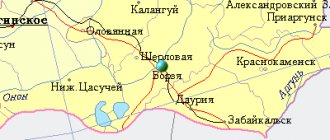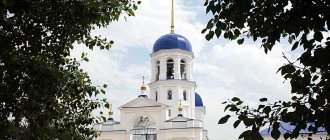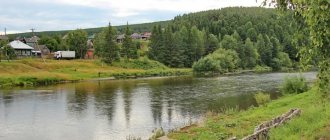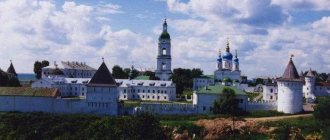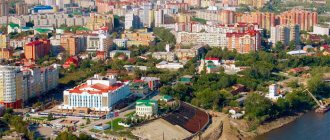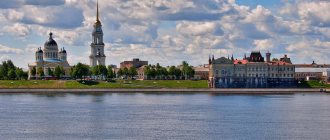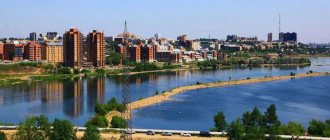City in Omsk region, Russia
| Kalachinsk Kalachinsk | |
| Town[1] | |
| Coat of arms | |
| Location of Kalachinsk | |
| Kalachinsk Location of Kalachinsk Show map of Russia Kalachinsk Kalachinsk (Omsk region) Show map of Omsk region | |
| Coordinates: 55°03′N 74°35'E / 55.050°N Latitude 74.583°E / 55.050; 74.583Coordinates: 55°03′N 74°35'E / 55.050°N. Latitude 74.583°E / 55.050; 74.583 | |
| A country | Russia |
| Federal subject | Omsk region[1] |
| Based | 1794 |
| Height | 100 m (300 ft) |
| population (2010 Census)[2] | |
| • General | 23,556 |
| • Evaluate (2018)[3] | 22,737 (−3.5%) |
| Administrative status | |
| • Subordinate | city of regional significance Kalachinsk[1] |
| • Capital from | Kalachinsky district[1], city of Kalachinsk of regional significance[1] |
| Municipal status | |
| • Municipal district | Kalachinsky municipal district[4] |
| • Urban village | Kalachinsk, town.[4] |
| • Capital from | Kalachinsky municipal district[4], urban-type settlement Kalachinsk[4] |
| Timezone | UTC + 6 (MSK + 3 [5]) |
| Postal code(s)[6] | 646900–646906, 646909 |
| OKTMO I WOULD | 52618101001 |
| Web site | www.kalachinsk.Information |
Kalachinsk
(Russian: Kalachinsk) is a town in Omsk Oblast, Russia, located on the Om River along the busiest segment of the Trans-Siberian Railway, 100 kilometers (62 mi) east of Omsk, then the administrative center of the region. Population: 23,556 (2010 Census);[2]24,247 (2002 Census);[7]25,014 (1989 Census).[8]
Kalachinsky district of Omsk region
General information about the Kalachinsky district The Kalachinsky district is located in the southern part of the West Siberian Plain, 88 km from Omsk. The area of the region is about 3000 square kilometers. Several highways and the Trans-Siberian Railway line pass through the territory of the region. The administrative center of the city of Kalachinsk is a major transport hub.
Climate of the Kalachinsky district The local climate can be described as moderate continental. The main features of the temperature regime are: short autumn and spring, warm and hot summer, harsh and cold winter. The average monthly air temperature in January reaches –19–20 degrees below zero. Once or twice a century the temperature dropped to minus 50–55 degrees. In July, the thermometer stops at +19 +20 degrees. 80% of precipitation falls during this period. Stable snow cover in the region forms in early November and disappears in early April.
Geographical characteristics of the Kalachinsky district
The territory of the Kalachinsky district is a flat watershed plain with a strongly pronounced western microrelief. There are chernozems, gray forest, meadow, floodplain and saline soils: solonchaks and solonetzes. Intensive human economic activity in recent years has led to increased gully formation. These processes are most clearly manifested on the steep and high slopes of the Omi River, where the city of Kalachinsk is located. The region's lakes have increased mineralization and are noticeably drying out.
Flora and fauna of the Kalachinsky district The territory of the Kalachinsky district is located in the southern forest-steppe zone. Here, birch groves and forest groves alternate with steppe meadows, where crescent alfalfa, meadowsweet, steppe timothy grass, etc. grow. In the center or on the outskirts of forest groves there are meadow-marsh communities with a predominance of grasses and sedges. White, ash and Siberian willows grow in the undergrowth. The fauna includes about 130 species of birds and mammals. Sometimes a wolf and a lynx enter the territory. History of the Kalachinsky district Kalachinsky district was created in May 1925 by transforming the volost of the same name in the Omsk province. The new territorial unit became part of the Omsk Okrug of the Siberian Territory, and after its dissolution it was transferred to the direct subordination of the Omsk Region. Later, the area experienced several enlargements. Today, on its territory there are 55 settlements, home to about 40 thousand people. The city of Kalachinsk is located on the left bank of the river. Om. The first mention of the settlement dates back to 1795. The village got its name from Lake Kalachiki located nearby. The revival of economic life in the region coincided with the construction of the Siberian Highway and the Trans-Siberian Railway. In June 1925, the city was converted into a village, but later returned to its original status. In 1944, Kalachinsk became a workers' village, and in 1952 it became a city. Economy of the Kalachinsky district In terms of industrial production, the district occupies one of the first positions after the regional center. Of the branches of industrial specialization, the most developed is the food industry, which is represented by such enterprises as Kalachinsky Dairy Plant LLC, Kalachinsky Meat Processing Plant OJSC, a vegetable oil mill in the village of Tsaritsyno and many others. The industrial potential of the region consists of mechanical engineering and construction industry enterprises. Sights of the Kalachinsky district Since 1977, the “Kalachin Intersettlement History and Local Lore Museum” has been operating in the regional center. The building of the museum itself is recognized as a historical and architectural monument of the early 20th century. On the steep banks of the Om you can find the remains of ancient settlements and burial mounds. There are many lakes in the area where both local residents and residents of other areas of the Omsk region like to relax.
Story
XVIII century
The first exploration of the territory along the Omi River was carried out in 1755 by ensign Ukusnikov. In 1767, the head of the engineering expedition of the Siberian Corps, Major General Malm, first called the lake Kalachikami, which is a metaphor due to the shape of the lake.
The foundation of the village of Kalachiki was documented by the Revizskaya tale on January 26, 1795. At that time, 14 families numbering 130 people already lived in it. The date of foundation of the village is unknown exactly, approximately in 1783-1794 between the Revision tales.
The official founding date is the spring-summer of 1794. The first houses were built on the steep bank of the Om River, just below Lake Kalach formed by its old bed. The development of the village of Kalachiki proceeded slowly, since there were already small villages around or were newly established; there was never landownership in Kalachiki.
Interesting Facts
In 1960, film director Roman Karmen made a twenty-minute documentary about Kalachinsk, which was shown in all cinemas in the Omsk region and in Moscow.
Kalachinsk is the only city in the USSR in which DUKs (automatic disablers) were produced.
The city of Kalachinsk was visited by the President of the Russian Federation Vladimir Vladimirovich Putin during a trip to Russia.
On April 29, 2008, the IV annual forum-exhibition of business circles of Omsk and districts of the Omsk region was held in the district House of Culture.
My beloved city Kalachinsk issue 18
Brief historical backgroundInformation taken from the Official website of the city of Kalachinsk https://www.kalachinsk.info/ The first settlements east of the Omsk fortress arose on the northern bank of the Om River. The river was assigned the role of a natural barrier from nomadic tribes (Tatars, Kazakhs, Kyrgyz). The first information about settlers in the village of Kalachiki dates back to the capitation census of 1795. The census speaks of the resettlement of seven families from the volost center of the village of Kulikova (now the village of Kulikovo (right bank) of the Voskresensky rural settlement), who huddled mainly in adobe houses and mud huts at the junction of the river. Om and lakes Kalach. The first settlers were engaged in grain production, fishing, animal husbandry, weaving bast shoes and sewing clothes for their own needs. The surplus was sold through buyers who were engaged in purchasing for government needs and selling products to neighboring settlements and the Omsk fortress. At this time, the population growth of the Kalachiki village (village) was mainly due to natural growth and to a lesser extent due to the influx of population from other places. The main route of communication between the European part of the Russian Empire and Eastern Siberia and the Far East (Siberian Highway) passed north of the Om River, crossing the Irtysh River in the area of the village of Bolsherechye, along the present-day Gorky and Nizhneomsky regions. He did not have a significant influence on the development of Kalachikov. The first enterprises and public organizations: leather workshops, merchant houses, agricultural artels, a chapel on the street. The key one, Yamshchina, is, perhaps, all types of activity and employment of the population at the end of the 18th and 19th centuries. With the construction and commissioning of the railway and station at the end of the 19th century (now JSC Russian Railways and the Kalachinskaya station), the village of Kalachiki began to grow rapidly, “moving” gradually from the bend of the Omi River and Lake Kalach to the railway track. Families of railway workers and foremen settled along the railway: st. Zheleznodorozhnaya, Sadovaya, 30 Let Pobedy, Vokzalnaya, 1-4 Moving (now 70 Brigada, Gorky, Marshal Zhukov, Strelnikov St.). With the launch of the railway in 1880, the first water supply system and water tower were built for refueling steam locomotives, which ran along the street. Vodoprovodnaya (now Gagarina). Somewhat later, points were built to supply water to the population from the water supply system. At the beginning of the 20th century, there was no significant population growth. And only in 1914, according to the Stolypin reform, a significant increase in the population from outside was noted, including artisans, who significantly influenced the development of the economy. The first handicraft workshops for woodworking, making felt boots, furriers and sewing workshops, a forge, and weaving various products from wicker appeared. A market appeared that attracted traders from nearby settlements. The first enterprise, the Kalachinsky industrial plant, created in 1921, is now an empty territory in the area of the Kalachinsky forestry enterprise (Kombinatovskaya street). The industrial plant united artisans and was engaged in woodworking, making and firing bricks, making sleighs, carts, horse harnesses, barrels, household utensils, and wooden utensils. In 1922-24, the collectivization of agriculture was carried out, artels and collective farms were actively created for growing grain, meat, milk, the Kalachin machine and tractor station (now the Kalachin mechanical plant), a mill, warehouses for storing and shipping agricultural products appeared in close proximity to railway (elevator, oil and cheese depot, hay station). A consumer service plant is emerging. Around the same time (mid-20s), a molokanka (now a dairy plant) was created and a wooden bridge was built across the river. Om (third attempt. Two previous bridges were destroyed during spring floods). The development of medicine and education begins. The railway is also developing its infrastructure: an outpatient clinic and a hospital, a bathhouse, an elementary school, a school for deaf children, shops, a community center. With the commissioning of the bridge, communication between northern and southern settlements through Kalachinsk begins, and trade intensifies. In the 30s, the active development of Kalachinsk continued - it received the status of a workers' village. A technical inventory bureau, architectural and land management services, and a repair and construction site are being created. The presence of a railway and water supply attracts residents of neighboring settlements and regions. The construction of multi-apartment housing (2 apartments or more), mainly adobe and reed, begins. The manufactured bricks are used to construct kilns and transported to neighboring villages for the same purposes. The Kalachinsky meat processing plant and poultry workshop (poultry meat processing workshop) are being built from local materials. The following are being created: interdistrict base, public catering, RaiPO. At the same time, a semi-military organization was formed - an auto company, which in peacetime still consisted of up to 70 cars, repair shops for the repair and operation of the fleet. A geological exploration expedition was transferred to Kalachinsk (transferred from Kalachinsk in the mid-60s). These factors contribute to the development of general educational status. An 11-year school No. 1, several seven-year schools, kindergartens for the railway, MTS, and a meat processing plant are being built. During these years, only the railway had stone (brick) buildings. A service for forest protection plantations on the railway and forestry enterprises emerged, which were engaged in planting forests and caring for them. At the same time, the first few hectares of land in the MTS area were allocated for planting a garden on the initiative of amateur gardener Kirill Iosifovich Papko, who by this time had sufficient positive experience in breeding and preserving fruit-bearing trees and shrubs brought from the European part of the country in the harsh Siberian conditions . A cinema and teahouses are starting to operate, and a network of stores is developing. A weaving factory is being built. The 40s are of particular importance for Kalachinsk, as well as for the whole country. In 1941, a mechanical plant was evacuated from Melitopol to Kalachinsk to the MTS production base, which began producing military products in a matter of months. On September 30, 1942, by order of the Commander-in-Chief of the Siberian Military District, the formation of the 30th separate ski rifle brigade began in the Omsk region, headed by career military colonel P.M. Akimochkin. With unprecedented heroism and perseverance, at the cost of the lives of many soldiers and commanders, the brigade accomplished its task - firmly stabilizing the front line on the northern ledge of the future Battle of Kursk. Next to the venerable craftsmen, women and teenagers stood at the machines. SPTU-41 was created, which trains personnel mainly for a mechanical plant and a weaving factory, and after the war for agriculture and construction. The source of power supply for enterprises was diesel power plants. A new territory is allocated for the MTS base (later Agricultural Equipment). A fur shop is opening at KBO. A felted footwear workshop is being created on the basis of the industrial plant. A sniper school (now school No. 3), an airfield for training military pilots, an oil depot, and a military hospital are being created in Kalachinsk. During the war years, Kalachin residents made a golden contribution to the Great Victory. Our fellow countrymen are Heroes of the Soviet Union: Altunin A.T., Eremin A.S., Ermak P.I., Osminin P.E., Ledovsky I.G., Kalinin G.G.. The streets of the city are named after them. In 1941, the 70th Marine Brigade was formed in Kalachinsk, which, as part of the troops of the Western Front, closed the approaches to Moscow. On June 24, 1941, the Kalachin auto company was advanced to the combat area and was disbanded along the fronts. Drivers from Kalachin transported military cargo, the wounded, food along the “Road of Life”, and near Moscow, and on the Kursk Bulge and in many other directions. In the second half of the 40s, the district House of Culture, a library, and the first two-story houses made of brick and wood were built. The reorganization of agricultural production entailed the creation of inter-district agricultural machinery and an inter-collective farm construction organization. A branch of Sberbank, a clinic, a brewery, a veterinary hospital, a veterinary laboratory were created, and bathhouse No. 1 was opened. The 50s were marked by the arrival of electricity from the state grid in the region and the development of virgin and fallow lands. First of all, the railway is connected to the unified energy system. Traction was transferred from locomotive and diesel locomotive to electric locomotive. Traction and contact network services on the railway begin to operate. Enterprises, organizations and housing are gradually connected to power grids. The Kalachinsky district of electric networks, a public utility service, and a city electric grid are being created. In December 1952, Kalachinsk received the status of a city of regional subordination. The construction of inter-settlement and intra-city paved roads begins. The first asphalt streets: Vokzalnaya, Lenina, Kalachinskaya, 70 Brigades (1st Pereeznaya), Sovetskaya, Zavodskaya. Road construction organizations are being created: DSU-3 (DRSU-6), DRSU-3, PDU; general construction organizations of Omsktselinstroy: PMK-186, ZZHBI-4, UPTK, ATK-4; specialized construction organizations: SPMK-1266, PMK-106 "Meliovodstroy", PMK "Selkhozmontazh". Vtorchermet and Gortopsbyt workshops are being created, and the dead-end railway industry is being developed. The Ufa-Irkutsk oil and product pipeline was built and put into operation. A hotel (now a passport office) and a department store (Lenin Street) were built. The development of the educational and cultural network continues: a music school, a film library, film distribution, a mechanical plant club (now demolished), a city stadium (currently undergoing reconstruction). 60s. Mass construction of 2-3-storey housing in the central part of the city has begun, an overpass in the eastern part of the city instead of the railway. moving, Kalachinsky elevator, secondary schools No. 2 and 3, DOSAAF driving school, ATP-12, a cinema, a network of canteens and a restaurant, the territory of the fruit farm is increasing to 100 hectares. An asphalt concrete plant is being built. The development of utility networks continues and district boiler houses are being built. The children's art school accepts its first students. Outerwear buildings and a KBO shoe shop, a hotel, a motocross track (and now the best in Russia), more than 20 hockey rinks were built, a park area was created on Lake Kalach (PKiO named after Gagarin), a bath and laundry plant and bathhouse No. 3 were built, a children's youth school. 70s. The Kalachinsky meat processing plant with a capacity of 100 tons of meat per shift (1000 head of cattle is a giant), a telephone sewer system, a post office building, a bus station building, a central boiler house with networks is being built and put into operation (internal boiler houses have been transferred to communal facilities, garages, thermal chambers or dismantled). Construction of five-story housing has begun (Cherepova St., Stroitelnaya St.), children's factories. Raiselkhozkhimiya was created. The development of utility networks and the construction of paved roads continues. The fruit farm received an additional 1,140 hectares of land south of the city. Many administrative and business facilities are being put into operation, mainly located in apartment buildings (registry office, banks, pharmacy No. 13, dry cleaning, shops). The memorial complex was opened. 80s. The ZKSM, city water pipeline, city sewerage system, schools No. 5 and 6 have been built, housing construction continues. Construction of gas distribution networks has begun. New construction of roads and repairs of areas damaged during the construction of water supply and sewerage were carried out. A pedestrian overpass across the railway and a new railway building were built. station. 90s. Gas distribution networks are being built at an accelerated pace. The Kalachinskaya GDS was put into operation. Mid-rise buildings are being built to relocate citizens from demolished housing for gas pipelines. Cast iron water supply pipes are being replaced with polyethylene. Cottage development is actively underway according to targeted programs in the Zarechny, Western microdistricts, Solnechnaya Street. Builders - Bamovites - are moving to Kalachinsk. 2000s. Construction of gas distribution networks continues. The pressure sewer collector from the pumping station No. 1 (Klyuchevaya St.) to the pumping station of the meat processing plant was replaced, a water supply system was built from the pumping station of the 2nd lift (Voskresenka village) to the pumping station of the 3rd lift (Internatsionalnaya St.). Construction of a clean water pumping station is underway. Mid-rise housing is being built in the factory microdistrict. The stadium is being reconstructed. The memorial complex was reconstructed. The Church of the Resurrection of Christ (Semashko St.), shopping malls Geomart, ALPI, Blagodat, the tax office building, pharmacies, service stations, Sberbank branches have been built, private shops and household facilities (hairdressers, beauty salons) are being built. Individual entrepreneurship is growing. Currently, more than 900 individual entrepreneurs are registered on the territory of the Kalachinsky urban settlement.
